E‑bikes are transforming city life by blending sleek design, innovative tech, and eco-friendly features that make urban commuting stylish and sustainable. With advancements in batteries, motors, and smart connectivity, they offer longer rides and a personalized look that express your attitude. As they boost environmental benefits and foster vibrant communities, e‑bikes are shaping a new, cool way to explore and connect—discover how this silent revolution continues to redefine urban living.
Key Takeaways
- E-bikes offer a quiet, eco-friendly alternative to traditional transportation, embodying urban sophistication and sustainability.
- Stylish designs and customizable features make e-bikes a fashionable expression of personal identity.
- Integration of smart technology enhances user experience, positioning e-bikes as modern urban lifestyle symbols.
- Community events and group rides foster social status and shared urban culture around e-bike riding.
- E-bikes contribute to cleaner, quieter cities, redefining urban mobility as sleek, sustainable, and culturally relevant.
The Evolution of E‑Bike Design and Technology
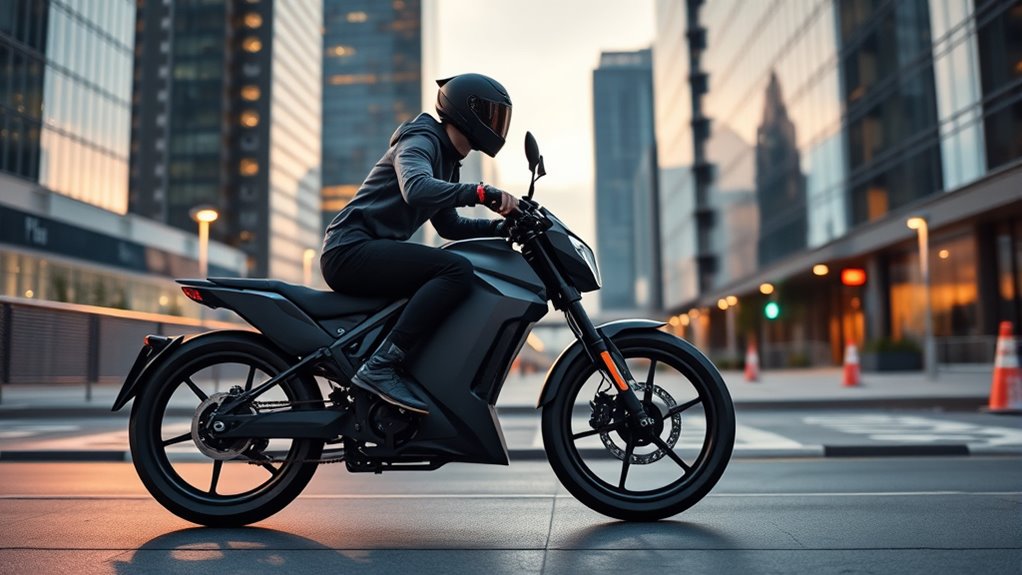
The evolution of e-bike design and technology has been driven by a desire to make urban commuting more efficient, fun, and sustainable. Battery advancements have played a vital role, enabling longer rides with quicker charging times and lighter, more compact packs. These improvements allow you to enjoy extended trips without the hassle of frequent stops. At the same time, design aesthetics have become a key focus, blending sleek lines and modern finishes to appeal to urban riders. Manufacturers now prioritize lightweight frames and minimalistic features, making e-bikes both stylish and practical. This combination of advanced batteries and thoughtful design means you get a vehicle that’s not only high-performing but also seamlessly integrates into your city lifestyle, elevating your daily commute with innovation and elegance. Additionally, automated manufacturing processes are increasingly being used to enhance quality and efficiency in e-bike production, ensuring consumers receive reliable and cutting-edge products. Incorporating advanced materials into frame construction further boosts durability and weight reduction, enhancing overall performance and rider experience. Moreover, the ongoing integration of smart technology allows for better connectivity and rider customization, enriching the urban cycling experience, and the adoption of predictive analytics is helping manufacturers anticipate market trends and consumer preferences, fostering continuous innovation in tech-driven transportation solutions.
E‑Bikes as a Statement of Urban Style
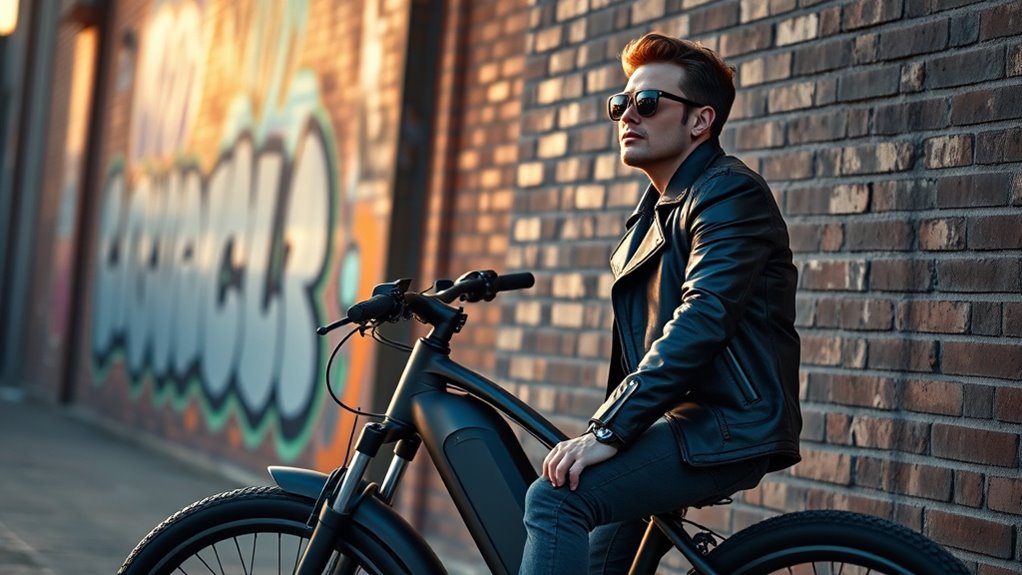
E‑bikes have become more than just a practical way to navigate the city; they’re now a powerful form of self-expression. Riding an e-bike is a fashion statement that reflects your personal identity and style. Whether you choose sleek, minimalist designs or bold, eye-catching colors, your bike communicates who you are. Custom accessories, unique decals, and innovative features let you personalize your ride, making it stand out in urban spaces. E‑bikes aren’t just transportation—they’re an extension of your personality. By selecting a design that aligns with your aesthetic, you signal your taste and attitude to the world. In this way, your e-bike becomes a statement piece that enhances your overall urban look and identity. Embracing self-reflection and growth can inspire you to choose designs that truly resonate with your inner values. Additionally, the urban mobility trends associated with e-bikes reflect a shift towards more sustainable and stylish transportation options. Recognizing the personality traits that influence your style choices can help you craft a more authentic and cohesive urban image. Understanding the importance of personal expression can further elevate the way you present yourself through your e-bike. Moreover, integrating environmental consciousness into your choices can reinforce your commitment to sustainability and match your stylish persona.
Environmental Impact and Sustainability in City Living
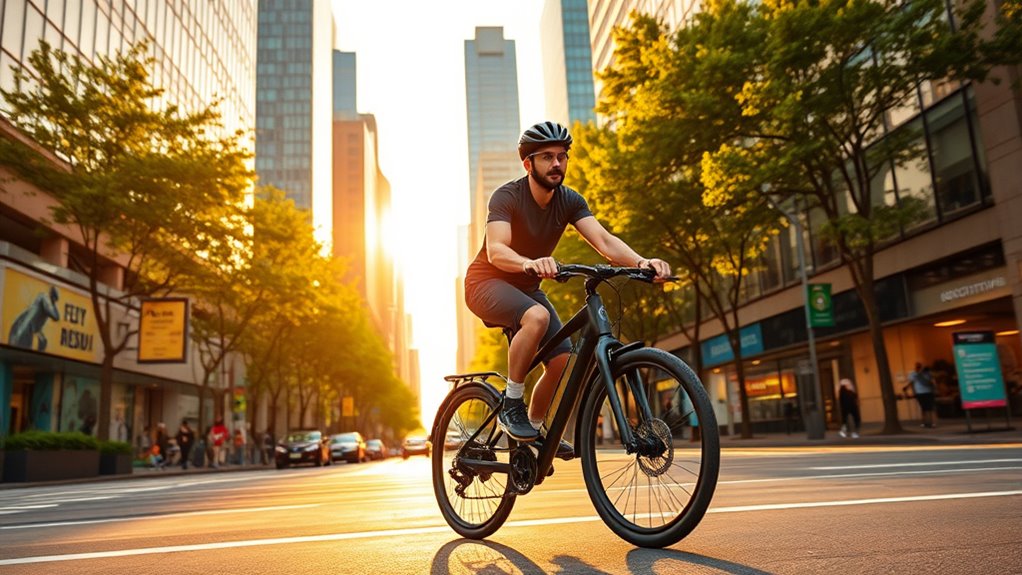
As cities grow more crowded and pollution levels rise, embracing sustainable transportation options becomes essential for reducing your environmental footprint. E-bikes contribute to this goal in several impactful ways:
- They lower emissions compared to cars, helping improve air quality.
- Using renewable energy to charge your e-bike enhances waste reduction by decreasing reliance on fossil fuels.
- E-bikes promote waste reduction by reducing the need for disposable transportation alternatives.
- They support urban sustainability by cutting down on noise pollution and energy consumption.
- Incorporating proper maintenance can extend the lifespan of e-bikes, further reducing resource consumption and environmental impact. Additionally, choosing eco-friendly materials for e-bike components can further minimize environmental effects over the product’s lifecycle.
- Implementing recycling programs for e-bike parts ensures responsible disposal and reduces electronic waste.
- Promoting community awareness about sustainable options also encourages wider adoption of eco-friendly transportation.
- Adoption of sustainable manufacturing practices can further lower the overall environmental footprint of e-bike production, making them an even greener choice for urban commuters.
Building Community and Culture Around E‑Bike Use
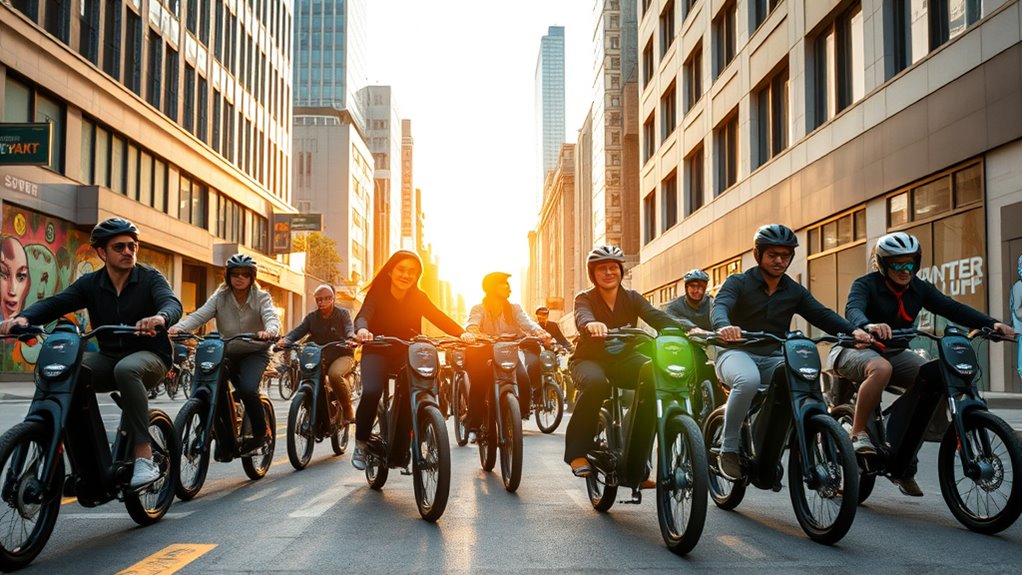
Building a community around e-bike use can transform individual rides into shared experiences that foster connection and a sense of belonging. Attending local meetups allows you to meet fellow enthusiasts, exchange tips, and discover new routes together. These gatherings create a lively atmosphere where friendships develop and riding becomes more than just transportation—it’s a social activity. Cycling festivals take this sense of community further, offering an opportunity to celebrate e-bike culture through group rides, workshops, and competitions. Participating in these events helps you feel part of a growing movement that values sustainability, innovation, and urban exploration. Engaging with others who share your passion can also inspire cultural and regional breakfasts, enhancing the overall experience and promoting a healthier, more connected environment. By engaging with others who share your passion, you’ll strengthen the culture around e-bikes and contribute to a more connected, vibrant urban environment. Incorporating AI security measures can also enhance safety during group rides by providing real-time threat detection and communication support. Additionally, fostering community engagement is essential for expanding awareness and encouraging more people to adopt sustainable transportation options.
The Future of Urban Mobility and E‑Bike Innovation
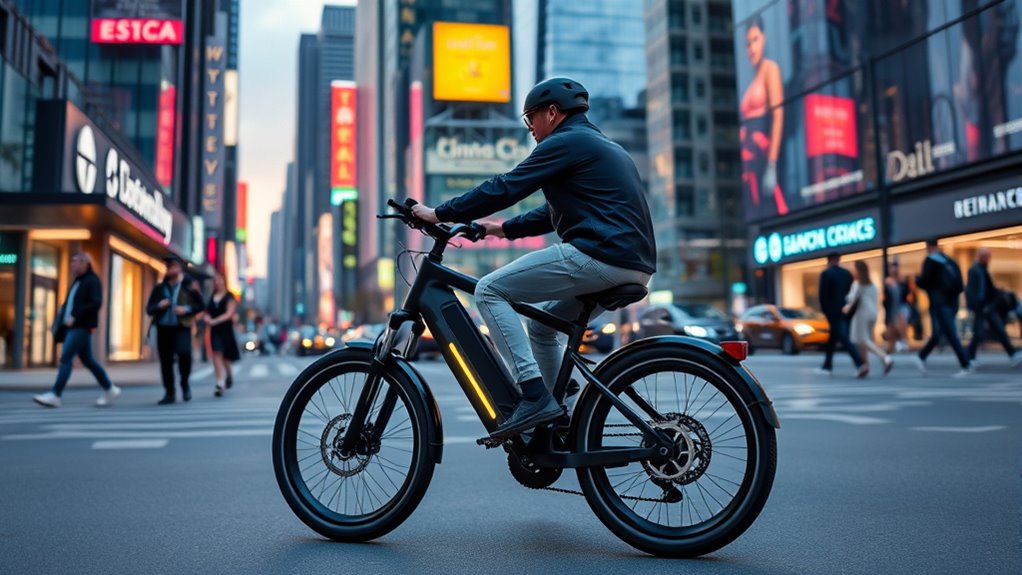
The growing community around e-bike use signals a shift toward more innovative and sustainable urban transportation solutions. Future developments will focus on:
- Battery innovations that extend range, reduce weight, and improve charging times, making e-bikes more efficient and accessible. Advances in battery technology will play a crucial role in enhancing overall performance and user experience.
- Upgraded urban infrastructure that includes dedicated bike lanes, charging stations, and secure parking, encouraging more riders.
- Smart technology integration, such as AI-powered navigation and maintenance alerts, enhancing your riding experience.
- Regulatory changes supporting e-bike use, like simplified registration and safety standards, making adoption smoother.
- Advances in noise levels reduction technology in components like motors and hubs will make e-bikes even quieter, enhancing urban comfort. Additionally, innovative renewable energy applications, such as solar-powered charging stations, are being developed to further promote sustainable mobility.
These advancements will transform city living, making e-bikes a core part of urban mobility. You’ll enjoy faster, greener, and more connected transportation options that redefine how you move through the city.
Frequently Asked Questions
How Do E-Bikes Compare to Traditional Bikes in Terms of Maintenance?
You’ll find that e-bikes generally require less chain maintenance since the motor reduces the strain on the chain. However, you need to keep an eye on the battery, as it may need replacement after a few years of regular use. Unlike traditional bikes, e-bikes have more components, but with proper care, such as regular cleaning and timely battery checks, they can be quite reliable and low-maintenance.
Are E-Bikes Affordable for the Average City Resident?
They say “you get what you pay for,” and that holds true with e-bikes. While the initial cost comparison shows e-bikes can be pricier than traditional bikes, affordability factors like lower maintenance costs and savings on fuel balance the scales. For the average city resident, e-bikes are increasingly accessible, especially with options like financing or subsidies. Overall, they’re becoming a smart investment for daily commuting.
What Safety Features Are Included in Modern E-Bike Models?
Modern e-bike models come equipped with essential safety features like advanced helmet safety systems, which protect your head during falls or collisions. Many also include theft prevention measures, such as integrated locks, GPS tracking, and alarm systems that deter theft. These features help guarantee your safety and peace of mind while riding, making e-bikes a secure and reliable transportation option in urban environments.
Can E-Bikes Be Integrated With Public Transportation Systems?
Think of your commute as a puzzle, and e-bike integration is the missing piece. You can easily connect your e-bike with public transit systems, like folding bikes that fit on buses or trains, making your journey seamless. Many cities are expanding public transit options to include bike racks and dedicated spaces, so you can switch from pedal power to transit without missing a beat. This fusion streamlines urban travel and boosts flexibility.
How Do Cities Regulate E-Bike Usage and Parking?
Cities regulate e-bike usage and parking by establishing bike lane policies and designated parking zones. You should follow local rules, use bike lanes where available, and park only in approved areas to avoid fines. Some cities restrict e-bike speeds or require registration. By adhering to these regulations, you help keep streets safe and organized, ensuring everyone benefits from the convenience and eco-friendly benefits of e-bikes.
Conclusion
As e‑bikes continue to reshape cities, they’re not just transportation tools but symbols of style, sustainability, and social synergy. Embrace this evolving era of urban excitement, where innovation ignites individual identity and inspires interconnected communities. By riding the wave of this silent revolution, you become part of a progressive, planet-friendly movement. Let’s lead with passion, purpose, and pedal-powered pride—because the future of urban living is vibrant, verdant, and very much in your hands.









